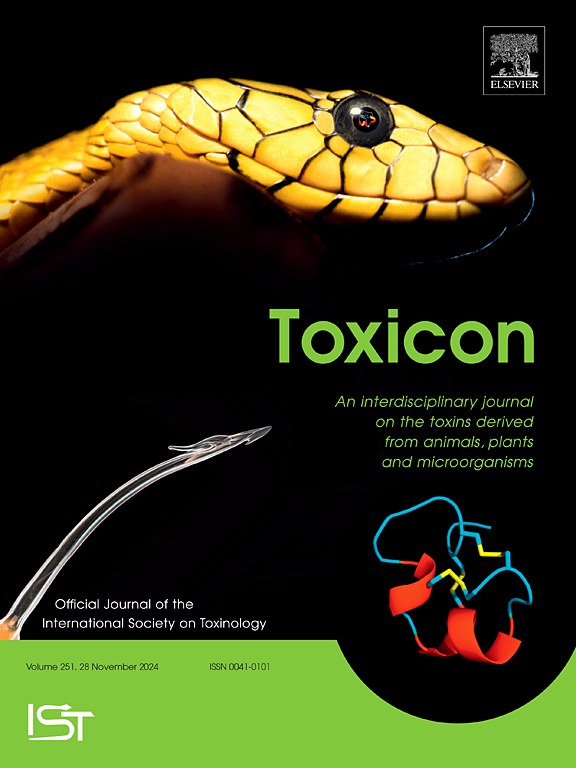亲和齿蟾粗毒液的细胞毒活性是由硫醇氧化和线粒体功能障碍介导的
IF 2.4
4区 医学
Q2 PHARMACOLOGY & PHARMACY
引用次数: 0
摘要
动物毒素,包括蚂蚁毒液,含有许多具有潜在生物医学和治疗用途的化合物。蚂蚁毒液主要由多肽和蛋白质组成,可能引起炎症反应和细胞毒性。一种巴西特有的掠食性蚂蚁Odontomachus affinis的毒液仍未得到充分的研究。在这里,我们评估了从O. affinis腺体中提取的毒液的细胞毒性活性,并研究了潜在的机制。对826只蚂蚁的腺体进行解剖,提取毒液,并用紫外-可见光谱、荧光光谱和色谱/质谱进行鉴定。MTT和台盼蓝法检测细胞活力,annexin V-FITC/PI流式细胞术检测细胞死亡类型。LDH释放评价质膜完整性。通过估算线粒体耗氧量和跨膜电位来评估线粒体生物能量。此外,还对蛋白质硫醇基团和还原性谷胱甘肽(GSH)进行了光谱分析。亲和草粗提物在紫外区表现出结构吸收带,最大吸光度在280 nm处,荧光发射带在350 ~ 360 nm处。色谱图显示其组成中至少有11种不同的分子。毒虫毒液对肝癌和白血病肿瘤细胞具有浓度依赖性的细胞毒性,在正常血细胞中也观察到这种毒性。此外,毒液有能力影响线粒体,增加氧气消耗。在白血病细胞中进行的机制研究表明,毒液诱导的细胞死亡伴随着质膜的通透性和蛋白质硫醇基团和谷胱甘肽的氧化,这与线粒体电位的耗散有关。因此,亲和蛇粗毒液通过触发线粒体通透性,影响线粒体生物能量和细胞氧化还原状态而表现出细胞毒性活性。本研究有助于进一步了解蛇毒的毒性机制,并展望其作为新型生物活性分子来源的潜力。本文章由计算机程序翻译,如有差异,请以英文原文为准。

Cytotoxic activity of the crude venom from Odontomachus affinis ants is mediated by thiol oxidation and mitochondrial dysfunction
Animal toxins, including ant venoms, contain numerous compounds with potential biomedical and therapeutic applications. Ant venoms are mostly composed by peptides and proteins that might elicit inflammatory responses and cytotoxicity. The venom of Odontomachus affinis, a predatory ant species endemic to Brazil, is still poorly studied. Here, we evaluated the cytotoxic activity of the venom extracted from O. affinis glands and investigated the underlying mechanisms. Glands from 826 ants were dissected, followed by venom extraction and characterization by UV–vis and fluorescence spectroscopy and also by chromatography/mass spectroscopy. Cell viability was determined by MTT and trypan blue assays and the type of cell death by flow cytometry using annexin V-FITC/PI. Plasma membrane integrity was evaluated by LDH release. Mitochondrial bioenergetics were evaluated by the estimation of mitochondrial O2 consumption and transmembrane potential. Also, protein thiol groups and reduced glutathione (GSH) were evaluated by spectroscopy. The crude extract of O. affinis exhibited a structured absorbance band in the UV region with maximal absorbance at 280 nm and a fluorescence emission band at 350–360 nm region. The chromatogram revealed at least 11 different molecules in its composition. Odontomachus affinis venom exhibited a concentration-dependent cytotoxicity in hepatoma and leukemia tumor cells, which was also observed in normal blood cells. Also, venom had the ability to affect mitochondria, increasing O2 consumption. The mechanistic investigation conducted in leukemia cells revealed that venom induced-cell death was accompanied by plasma membrane permeabilization and oxidation of protein thiol groups and glutathione, which was associated with the dissipation of mitochondrial potential. Thus, O. affinis crude venom exhibits cytotoxic activity by triggering of mitochondrial permeabilization, affecting mitochondrial bioenergetics and cellular redox state. This study contributes to the comprehension of the mechanisms of toxicity of O. affinis venom and also prospects its potential as a source for novel bioactive molecules.
求助全文
通过发布文献求助,成功后即可免费获取论文全文。
去求助
来源期刊

Toxicon
医学-毒理学
CiteScore
4.80
自引率
10.70%
发文量
358
审稿时长
68 days
期刊介绍:
Toxicon has an open access mirror Toxicon: X, sharing the same aims and scope, editorial team, submission system and rigorous peer review. An introductory offer Toxicon: X - full waiver of the Open Access fee.
Toxicon''s "aims and scope" are to publish:
-articles containing the results of original research on problems related to toxins derived from animals, plants and microorganisms
-papers on novel findings related to the chemical, pharmacological, toxicological, and immunological properties of natural toxins
-molecular biological studies of toxins and other genes from poisonous and venomous organisms that advance understanding of the role or function of toxins
-clinical observations on poisoning and envenoming where a new therapeutic principle has been proposed or a decidedly superior clinical result has been obtained.
-material on the use of toxins as tools in studying biological processes and material on subjects related to venom and antivenom problems.
-articles on the translational application of toxins, for example as drugs and insecticides
-epidemiological studies on envenoming or poisoning, so long as they highlight a previously unrecognised medical problem or provide insight into the prevention or medical treatment of envenoming or poisoning. Retrospective surveys of hospital records, especially those lacking species identification, will not be considered for publication. Properly designed prospective community-based surveys are strongly encouraged.
-articles describing well-known activities of venoms, such as antibacterial, anticancer, and analgesic activities of arachnid venoms, without any attempt to define the mechanism of action or purify the active component, will not be considered for publication in Toxicon.
-review articles on problems related to toxinology.
To encourage the exchange of ideas, sections of the journal may be devoted to Short Communications, Letters to the Editor and activities of the affiliated societies.
 求助内容:
求助内容: 应助结果提醒方式:
应助结果提醒方式:


